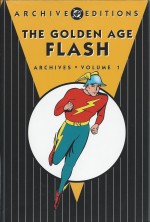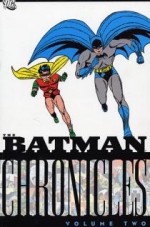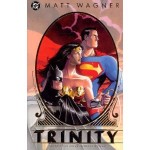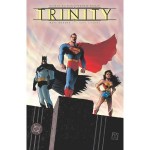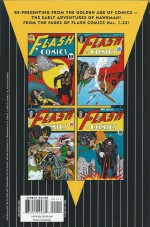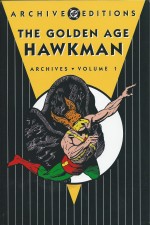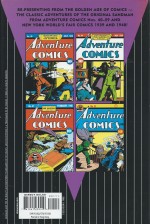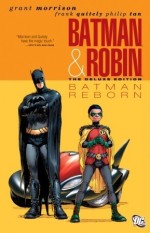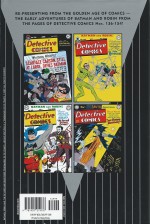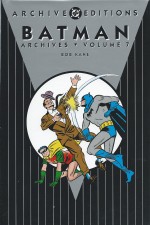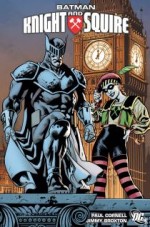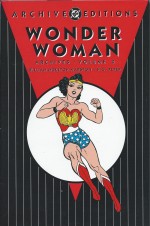New, Revised Review

By Judd Winick & Joshua Middleton (DC Comics)
ISBN: 978-1-4012-0923-0
At their most impressive, superhero comics combine all the gravitas of mythology with all the sheer child-like fun and exuberance of a first rollercoaster ride. A perfect example of this is the 4-issue miniseries from November – February of 2006 collected as Superman/Shazam!: First Thunder.
One of the most venerated and loved characters in American comics, (the original) Captain Marvel was created by Bill Parker and Charles Clarence Beck as part of the wave of opportunistic creativity that followed the successful launch of Superman in 1938. Although there were many similarities in the early years, the Fawcett character moved solidly into the area of light entertainment and even comedy, whilst as the 1940s progressed the Man of Steel increasingly left whimsy behind in favour of action and drama.
At the height of his popularity the World’s Mightiest Mortal outsold the Man of Steel by a wide margin and was even published twice-monthly, but as the Furious Forties closed tastes changed, sales slowed and Fawcett saw the way the wind was blowing. They settled an infamous long-running copyright infringement case instigated by DC/National in 1940 and the Big Red Cheese vanished – as did so many superheroes – becoming little more than a fond memory for older fans.
As America lived through another superhero boom-and-bust from 1956-1968, the 1970s dawned with a shrinking industry and a wide variety of comics genres servicing a base that was increasingly founded on collector/fans and not casual or impulse buys. DC Comics needed sales and were prepared to look for them in unusual places.
After the settlement with Fawcett in 1953 they had secured the rights to Captain Marvel and Family, and even though the name itself had been taken up by Marvel Comics (via a circuitous and quirky robotic character published by Carl Burgos and M.F. Publications in 1967) decided to tap into that discriminating older, nostalgia fuelled fan-base, even as the entire entertainment world began looking back in time for fresh entertainments such as The Waltons or Little House on the Prairie…
In 1973, riding that burgeoning wave of nostalgia, DC brought back the entire beloved cast of the Captain Marvel strips: restored to their own kinder, weirder universe. To circumvent an intellectual property clash, they entitled the new comic book Shazam! (‘With One Magic Word…’; the trigger phrase used by the Marvels to transform to and from mortal form and a word that had already entered the American language due to the success of the franchise the first time around.
You know what comics fans are like: they had been arguing for decades – and still do – over who was best (for which read “who would win if they fought?â€) out of Superman or Captain Marvel. Eventually, though excised from the regular DCU and stuck on a parallel universe, the old commercial rivals met and clashed a number of times, but until the landmark Crisis on Infinite Earths subsumed all those myriad worlds into one overarching continuity, the most powerful heroes in existence maintained the status of “equal but separateâ€.
In that new reality everything happened in one cosmos and Captain Marvel was fully rebooted and integrated. The basics remained untouched: homeless orphan and good kid Billy Batson was selected by an ancient wizard to be given the powers of six gods and heroes to battle injustice. He is given the ability to transform from scrawny precocious kid to brawny (adult) hero by speaking aloud the wizard’s acronymic name – invoking the powers of legendary patrons Solomon, Hercules, Atlas, Zeus, Achilles and Mercury.
After twenty years in this iteration, Captain Marvel’s early days were re-explored in this canny, big-hearted thriller which reveals the details of the first shared case of paragons of power.
Written by Judd Winick and illustrated by Joshua Middleton in a painterly style gloriously reminiscent of the old Fleischer Studio Superman cartoons, this magical treat is chronologically set just after Superman: Man of Steel volume 1 and The Power of Shazam! original graphic novel, and opens with ‘A Face in the Crowd’ as a new hero begins saving lives in West Coast Fawcett City, whilst a continent eastwards in Metropolis, Superman stumbles onto a museum robbery and is surprisingly beaten by thieves employing magic. The robbers belong to a cult – the Temple of Bagdan – and are on a nationwide spree to collect ancient Russian relics for some sinister master-plan…
In Fawcett, Marvel destroys giant robots attacking a new solar powered construction site designed by Doctor Bruce Gordon, unexpectedly inspiring the enmity of billionaire industrialist Thaddeus Sivana. Although the owner of the Solar Center project, Sivana has huge petrochemical interests and only intended his eco-friendly enterprise as a tax-shelter. He certainly has no intention of supplying cheap, clean energy to the proles of “his†city…
In a make-shift shelter, homeless kid Billy Batson talks his day over with Scoot Cooper, another hard-luck kid and the only person who knows his secret, even as Sivana deals with his hated East Coast rival Lex Luthor. The arrogant Metropolis financier has experience with super-powered meddlers and resources to combat their interference. It’s time to make a deal with a devil…
Later when the Bagdan cultists raid Fawcett’s McKeon History Museum, Marvel is waiting for them but is also overmatched by the magical Mallus Trolls employed by the thieves. At least until Superman shows up…
The team-up explodes into action in ‘Odd Couples’ with the heroes battling together, discovering their similarities and major differences even as in Metropolis Luthor sells Sivana the answer to all his superhero problems: an exemplary operative dubbed Spec…
The cultists have again escaped however and are in the final stage of their plan. Having secured the mystic paraphernalia to summon consummate evil they then force disturbed kidnap victim Timothy Barnes to become host to six infernal fiends. Sabbac is the antithesis of Shazam’s agent: a supernatural super-being sponsored by devil-lords Satan, Aym, Belial, Beeelzebub, Asmodeus and Createis in the way the ancient gods and heroes empower Captain Marvel, and he is free to wreak havoc and destruction upon the world.
To make matters worse, at that very moment Bruce Gordon succumbs to his own twilight curse at the Solar Centre as a lunar eclipse allows the diabolical Spirit of Vengeance to escape from his fleshy prison…
‘Titans’ finds Captain Marvel furious battling his dark counterpart as Superman struggles against not only the evil Eclipso but also his possessed army of innocents enslaved by the dark destroyer’s black diamond. When Sivana secretly funded the cultists he intended their tool to simply destroy Gordon and his power plant but now events have spiralled beyond anyone’s control. Even as the hated heroes inadvertently fix both of Sivana’s awry schemes, Spec is hunting through Fawcett. Soon his astounding abilities have ferreted out Billy Batson’s secret and arranged a permanent solution…
The drama roars to a terrific conclusion in ‘Men and Boys! Gods and Thunder!’ as a paramilitary hit squad attempts to gun down the merely human Billy but only hits his best friend instead, leaving Sivana to face the wrath of a lonely, bitter 10-year old boy, amok and enraged with righteous fury in the body of one of the most powerful creatures in the universe…
In the awesome aftermath Superman decides to deal with the shell-shocked Marvel in a way that will change both of their lives forever…
This is a big, bold, grand old fashioned comicbook romp full of big fights, dastardly villains, giant monsters, big robots and lasting camaraderie that will delight all lovers of Fights ‘n’ Tights fiction, and whilst not a breakthrough classic like Watchmen or The Dark Knight Returns, is an equally mythic retelling of superhero mythology which ranks amongst the very best of the genre.
© 2006 DC Comics. All Rights Reserved.


